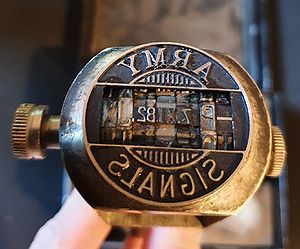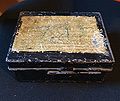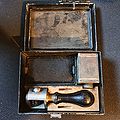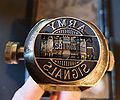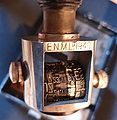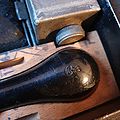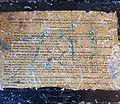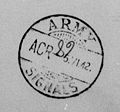Stamps, Army Signal, Dating, Mk II
From RCSigs.ca
Stamps, Army Signal, Dating, Mk II is an office style stamp from the Second World War period. The complete set consisted of a japanned tin case containing the steel dating stamp itself with revolving date and code-letter wheels along with inking pad and tray, rubber stamping pad and screw-capped ink flask.
The example shown below is unfortunately missing the rubber stamping pad but is otherwise complete. The stamp body has the manufacture's mark "E.N.M. Ld" (E.N.M stands for English Numbering Machines Ltd, Enfield, England) as well as the year of manufacture, 1940, engraved on it. The stamp's black wooden handle shows a British crown ordnance mark overlaid by a C-broad arrow Canadian Government ownership mark. Period documentation can be found marked with such stamps confirming their use.
Instructions
The top of the tin has the instructions for use:
- 1. When in use in an office, keep the open lid with rubber stamping pad towards you.
- 2. To ink the pad. -- Take out the ink flask, turn down the right-hand clip and remove the ink pad from its tray. Pour some ink into the tray and replace the pad. Beat the pad with the stamp and then reverse it, repeating the process until the pad is sufficiently saturated with ink.
- 3. Keep the cap of the flask well screwed home.
- 4. To use the stamp. -- Tap in twice on the ink pad, lay the form on the rubber pad, then place the stamp where required, and press firmly and evenly.
- N.B. -- Do not use the stamp with a blow. Do not ink or grease the rubber pad.
- 5. To alter date or code-letter wheels. -- Unscrew the locking pin, and withdraw it, shift the wheels as required, working them round with the thumb and forefinger, or with a piece of wood. Commence with the right-hand wheel, pushing the pin in as each wheel is placed.
- 6. Two of the letter wheels are engraved from A to M and the other two from N to Z, each wheel having one blank tooth. The relative position of these wheels can, if necessary, be changed by unscrewing and withdrawing the spindle, removing and replacing the wheels through the slot in the body of the stamp. In replacing the wheels be careful that the figures and letters are not upside down. In withdrawing and replacing the wheels keep the top and bottom letters or figures parallel to the face of the stamp, otherwise they will "jamb."
- 7. In packing up the stamp, be careful that the ink pad is securely clipped down, and that he stamp is laid in on its side, so that the lid may close properly.
- 8. Ordinary Morse Ink can be used on the ink pad, but De La Rue's "Obliterating Ink" gives much better results.
Photos
Related Pages
- No related pages at this time
